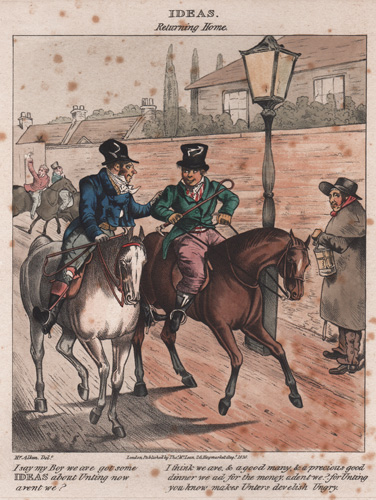Darvill's Rare Prints is pleased to offer a large selection of original Henry Alken etchings.
Henry Alken etchings and engravings are available from:
"Illustrations to Popular Songs" (1823)
"Symptoms of Being Amused" (1822)
"Sporting Prints" (circa 1830)
Illustrations of popular songs of the day, Alken's imaginative vignettes illustrate the songs line by line. Their fine execution and hand-color make them wonderful examples of Alken's work.
"Sporting Prints"
by Henry Alken
Published by Thomas McLean,
London
circa 1830
Original Antique Hand-colored stone lithographs
Sheet Size: 11 x 14 inches
Image Size: 7 x 8½ inches
Condition: Fair/Good, with overall scattered foxing.
These lithographs
are printed or backed
on a stiff card stock.
Some prints
may have signs of foxing or other age-related defects. Please
have a look at
the enlarged
photos for the
best indication
of each print's
condition.
(note; entire image did not fit on scanner.)
A bit about Henry Alken:
Sporting artist, engraver and illustrator.
Born in London in 1784 into a family which became celebrated for its sporting artists and engravers. He is said to have worked as a trainer for the Duke of Beaufort, before studying under T. Barker Beaumont, the miniaturist, and he exhibited miniatures at the RA in 1801-2.
He moved to Melton Mowbray in 1810 to train horses. and eke out a livelihood in decorating trays with hunting scenes. His success really began when he issued prints under the name of "Ben Tally Ho" in 1813 and was at his most prolific in the 1820s and 1830s. His work was less interesting after that date and he died in poverty on April 8, 1851. His son H.G. Alken copied his father's work extensively.
Alken illustrations and separate prints are lively and very colourful and are closer to the 18th century caricature than to the 18th century sporting print. He enlarged Gillray's idea that the mishaps of hunting could be depicted in the same format as scenes of The chase and his publisher was significantly Thomas M'Lean of 'The Repository of Wit and Humour'.
Shaw Sparrow considers that he was most influential in creating a medium in which Phiz, Leech, and Caldecott could flourish. His Sketchbook, 1823 and Scrapbook, 1824 with pages crammed with nearly related but separated incidents, may have influended strip stories in the Victorian magazines. His drawings are most often seen in soft pencil with colour washes.
(from "The Dictionary of British Book Illustrators and Caricaturists, 1800-1914" by Simon Houfe)
collection for you!
|














